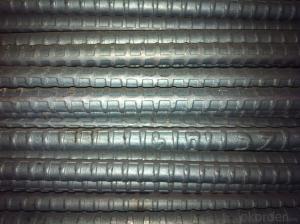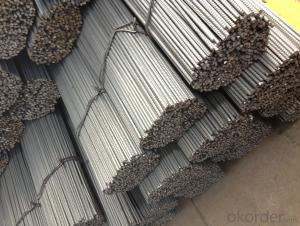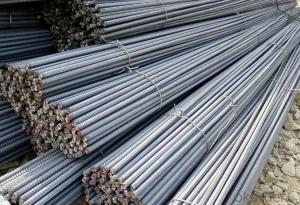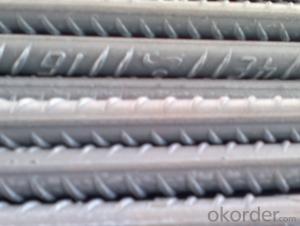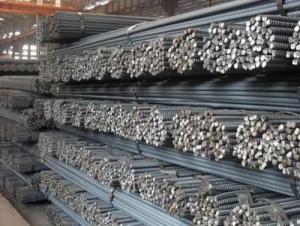Deformed Steel Bar, 10mm 12mm Steel Rebar
- Loading Port:
- China main port
- Payment Terms:
- TT or LC
- Min Order Qty:
- 100 m.t.
- Supply Capability:
- 100000 m.t./month
OKorder Service Pledge
OKorder Financial Service
You Might Also Like
Product Description:
OKorder is offering Deformed Steel Bar, 10mm 12mm Steel Rebar at great prices with worldwide shipping. Our supplier is a world-class manufacturer of steel, with our products utilized the world over. OKorder annually supplies products to African, South American and Asian markets. We provide quotations within 24 hours of receiving an inquiry and guarantee competitive prices.
Product Applications:
Deformed Steel Bar, 10mm 12mm Steel Rebar are ideal for structural applications and are widely used in the construction of buildings and bridges, and the manufacturing, petrochemical, and transportation industries.
Product Advantages:
OKorder's Deformed Steel Bar, 10mm 12mm Steel Rebar are durable, strong, and wide variety of sizes.
Main Product Features:
· Premium quality
· Prompt delivery & seaworthy packing (30 days after receiving deposit)
· Can be recycled and reused
· Mill test certification
· Professional Service
· Competitive pricing
Product Specifications:
Manufacture: Hot rolled
Grade: HRB335,HRB400,HRB500
Certificates: ISO, SGS, BV, CIQ
Length: 6m – 12m, as per customer request
Packaging: Export packing, nude packing, bundled
Deformed Steel Bar | ||
Diameter (MM) | Cross Sectional Area (MM2) | Theorectical Weight (KG/M) |
6 | 28.27 | 0.222 |
8 | 50.27 | 0.395 |
10 | 78.54 | 0.617 |
12 | 113.1 | 0.888 |
14 | 153.9 | 1.21 |
16 | 201.1 | 1.58 |
18 | 254.5 | 2 |
20 | 314.2 | 2.47 |
22 | 380.1 | 2.98 |
25 | 490.9 | 3.85 |
28 | 615.8 | 4.83 |
32 | 804.2 | 6.31 |
36 | 1018 | 7.99 |
40 | 1257 | 9.87 |
Grade | Technical data of the original chemical composition (%) | |||||||
C | Mn | Si | S | P | V | |||
HRB500 | ≤0.25 | ≤1.60 | ≤0.80 | ≤0.045 | ≤0.045 | 0.04-0.12 | ||
Physics capability | ||||||||
Yield Strength(N/cm2) | Tensile Strength(N/cm2) | Elongation (%)
| ||||||
≥500 | ≥630 | ≥12 | ||||||
FAQ:
Q1: Why buy Materials & Equipment from OKorder.com?
A1: All products offered byOKorder.com are carefully selected from China's most reliable manufacturing enterprises. Through its ISO certifications, OKorder.com adheres to the highest standards and a commitment to supply chain safety and customer satisfaction.
Q2: How many tons of steel products could be loaded in containers?
A2: Usually the steel products are delivered by bulk vessel because of the large quantity and the freight. However, there are no bulk vessel enter some seaports so that we have to deliver the cargo by containers. The 6m steel product can be loaded in 20FT container, but the quantity is changed according to the size, usually from 18tons to 25tons.
Q3: How soon can we receive the product after purchase?
A3: Within three days of placing an order, we will arrange production. The normal sizes with the normal grade can be produced within one month. The specific shipping date is dependent upon international and government factors, the delivery to international main port about 45-60days.
Images:
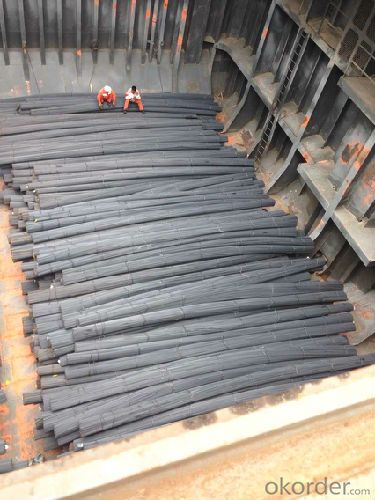
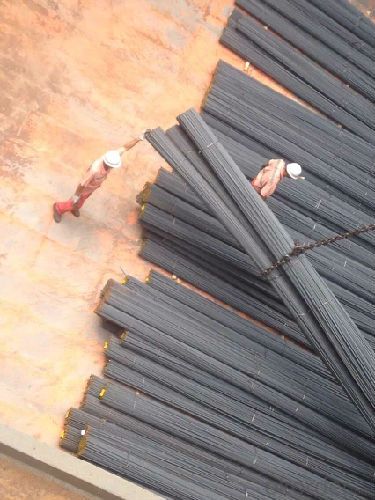
- Q:Can steel rebars be used in energy-efficient buildings?
- Certainly! Energy-efficient buildings can indeed incorporate steel rebars. These rebars are commonly utilized in the construction of reinforced concrete structures, including those that prioritize energy efficiency. Energy-efficient buildings aim to decrease energy consumption and minimize their environmental footprint. Although steel is a material with high embodied energy, meaning it requires a substantial amount of energy for production, it boasts numerous advantages for energy-efficient buildings. To begin with, steel rebars lend structural strength to reinforced concrete, enabling the creation of robust and long-lasting structures. This is pivotal for energy-efficient buildings, as their goal is to have an extended lifespan and reduced maintenance requirements, thereby lessening their overall environmental impact. Additionally, steel rebars can be employed in the construction of energy-efficient building components, such as insulated concrete forms (ICFs) and precast concrete panels. These building systems possess exceptional thermal insulation properties, which decrease heat transfer and enhance energy efficiency. Steel rebars are utilized to reinforce these components, ensuring their structural integrity. Furthermore, the thermal mass characteristics of concrete, reinforced by steel rebars, can contribute to a building's energy efficiency. Concrete has the capability to absorb and store heat, aiding in the regulation of indoor temperatures and reducing the need for excessive heating or cooling. Consequently, this can result in significant energy savings throughout a building's lifespan. It is important to note that the energy efficiency of a building is contingent upon various factors, including insulation, window design, HVAC systems, and the integration of renewable energy. While steel rebars play a vital role in reinforced concrete structures, their impact on overall energy efficiency should be evaluated in conjunction with other design choices and building materials.
- Q:How are steel rebars installed in construction projects?
- Steel rebars play a vital role in reinforced concrete structures in construction projects. The installation process of these rebars encompasses several steps. To begin with, the construction plans and specifications are thoroughly examined to determine the required size, length, and placement of the rebars. This information is crucial to guarantee that the rebars provide the necessary strength and support to the structure. Subsequently, the rebars are cut and shaped according to the specifications. This is typically accomplished using specialized tools like rebar cutters and benders. The rebars are generally supplied in lengthy pieces and are cut to the desired size on-site. Once the rebars are prepared, they are positioned and firmly secured in the formwork or molds that will shape the concrete. This is achieved by placing the rebars in the desired locations and using wire or rebar ties to hold them in place. The ties are typically twisted around the rebars using pliers or a similar tool. This ensures that the rebars maintain their correct positions during the pouring and curing of the concrete. During the pouring phase of the concrete, the rebars are meticulously positioned to ensure even distribution and adequate spacing. This is crucial for providing structural integrity and preventing the formation of weak spots in the concrete. After the concrete is poured, it is left to cure and harden. During this period, the rebars become embedded within the concrete, establishing a strong bond. This bond creates a reinforced concrete structure capable of withstanding various loads and forces. To summarize, the process of installing steel rebars in construction projects involves cutting and shaping the rebars, accurately positioning them within the formwork, and securing them in place using ties. This process is critical for creating durable and robust reinforced concrete structures.
- Q:What is the elongation of steel rebars?
- The elongation of steel rebars pertains to how much they can deform or stretch before fracturing or breaking. It measures the ductility or flexibility of the steel rebars. Elongation is typically expressed as a percentage of the rebar's original length. The elongation of steel rebars varies based on the grade or type of steel used and the manufacturing processes involved. In general, steel rebars have a relatively high elongation compared to materials like concrete or timber. This makes them suitable for applications that require flexibility and resistance to deformation, such as reinforced concrete structures. Considering the elongation of steel rebars is crucial in structural design and construction. It affects the rebar's ability to withstand loads, particularly when subjected to tension or bending forces. Higher elongation values indicate a greater capacity for the rebar to stretch and deform without breaking, enhancing the overall performance and safety of the structure. To ensure the proper selection and utilization of steel rebars, it is essential to refer to the relevant standards and specifications provided by regulatory bodies and industry organizations. These guidelines outline specific requirements and recommendations for the elongation of steel rebars, along with other mechanical properties, to guarantee the structural integrity of construction projects.
- Q:What is the difference between hot-rolled and cold-worked steel rebars?
- The main difference between hot-rolled and cold-worked steel rebars lies in the manufacturing process. Hot-rolled steel rebars are produced by heating the steel billets to high temperatures and then passing them through rolling mills to create the desired shape and size. This process results in a rougher surface and higher yield strength compared to cold-worked steel rebars. On the other hand, cold-worked steel rebars are made by subjecting the hot-rolled steel bars to additional processing steps, such as cold drawing or cold rolling. This process enhances the mechanical properties of the steel, including improved tensile strength, dimensional accuracy, and a smoother surface finish. In summary, hot-rolled steel rebars are formed through high-temperature rolling, while cold-worked steel rebars undergo additional steps to further refine their properties, resulting in a smoother surface and improved mechanical strength.
- Q:How do steel rebars affect the overall creep and shrinkage of concrete structures?
- Steel rebars have a significant influence on the overall creep and shrinkage of concrete structures. The presence of rebars helps to control and minimize the shrinkage of concrete by providing restraint and reducing the amount of drying shrinkage. Additionally, rebars contribute to the overall stiffness of the structure, decreasing the potential for creep deformation over time. Therefore, steel rebars play a crucial role in mitigating both creep and shrinkage in concrete structures, ensuring their stability and durability.
- Q:How are steel rebars protected against electromagnetic interference?
- Steel rebars are typically protected against electromagnetic interference through the use of concrete cover. The concrete acts as a shield, preventing electromagnetic waves from interfering with the steel rebars. Additionally, proper grounding and bonding techniques are employed to further enhance protection against electromagnetic interference.
- Q:How do steel rebars impact the overall constructability and scheduling of concrete projects?
- Steel rebars have a significant impact on the overall constructability and scheduling of concrete projects. They provide structural reinforcement to concrete, increasing its strength and durability. The inclusion of rebars in the concrete design requires careful planning and coordination, as they need to be accurately positioned and supported within the concrete forms. This process can add complexity to the construction process, potentially affecting the project's timeline. However, rebars ultimately enhance the project's constructability by ensuring the structural integrity of the concrete elements, leading to safer and more reliable structures.
- Q:How do steel rebars affect the overall acoustic properties of a structure?
- The overall acoustic properties of a structure are greatly affected by steel rebars, also known as reinforcement bars. Steel rebars can have both positive and negative effects on the acoustic characteristics of a building or infrastructure. One way in which steel rebars impact the acoustic properties is through their ability to transmit sound vibrations. Steel, being a good conductor of sound, easily allows sound waves to travel. Consequently, when steel rebars are present in a structure, they act as pathways for sound transmission, allowing it to easily travel throughout the building. This can result in increased noise levels and reduced acoustic privacy, as sound waves can travel through the steel rebars and reach different areas of the structure. However, steel rebars can also contribute to the overall sound insulation of a structure. When properly installed and integrated with other construction materials like concrete or acoustic insulation materials, steel rebars help reduce the transmission of sound waves. The stiffness and mass of steel rebars help dampen the vibrations caused by sound waves, thereby reducing the amount of sound that passes through the structure. This enhances the acoustic comfort within the building, creating a quieter environment suitable for various activities that require reduced noise levels. It is important to note that the impact of steel rebars on the acoustic properties of a structure depends on various factors, including the thickness and density of the surrounding construction materials, the arrangement and spacing of the rebars, and the overall design of the building. Additionally, the use of additional acoustic treatments like sound-absorbing panels or insulation can further improve the acoustic performance of a structure by mitigating the negative effects of steel rebars. In conclusion, steel rebars play a significant role in the overall acoustic properties of a structure. While they can facilitate the transmission of sound waves, they can also contribute to sound insulation when combined with appropriate construction materials and techniques. Proper design and implementation, along with the use of additional acoustic treatments, are crucial in achieving the desired acoustic environment in buildings and infrastructure where steel rebars are present.
- Q:What is the process of handling and transporting steel rebars on-site?
- Ensuring the safe and efficient movement of steel rebars on-site involves a series of steps. To begin, the construction site receives the steel rebars, unloading them from the delivery truck and inspecting for any damage or defects. Once unloaded, the rebars are stored in a designated rebar yard, where they are arranged and stacked for easy access and protection against damage or tangling. Depending on the construction project's requirements, the rebars may be cut or bent to a specific shape before installation, utilizing specialized tools and equipment. After cutting and bending, the rebars are transported to the designated work area on the construction site. This can be done manually by workers or with the assistance of mechanical equipment like cranes or forklifts for larger quantities. In the work area, the rebars are installed according to the project's design and specifications, being placed within the appropriate positions in the concrete structure. Throughout the entire process, strict adherence to safety guidelines is crucial to prevent accidents or injuries. This includes wearing protective gear and ensuring that the rebars are handled and transported in a manner that minimizes the risk of tripping or falling. Regular inspections should also be conducted to detect any damage or defects, as these can compromise the structural integrity of the construction project.
- Q:How do steel rebars affect the overall sustainability certifications of a structure?
- The sustainability certifications of a structure can be significantly influenced by steel rebars. Certifications like LEED or BREEAM assess a building's environmental performance based on various factors, including the materials used. The sustainability of a structure can be affected by the production and use of steel rebars in several ways. Firstly, the production of steel consumes a significant amount of energy and emits greenhouse gases. However, many steel manufacturers have implemented energy-efficient technologies and use recycled materials to reduce their environmental impact. Therefore, the sustainability of steel rebars depends on production methods and the extent of recycled content. The durability and longevity of steel rebars also play a crucial role in a structure's sustainability. Steel's strength and resilience can greatly enhance a building's lifespan, reducing the need for frequent repairs and replacements. This reduces material waste and energy consumption associated with ongoing maintenance. Moreover, steel rebars contribute to a building's overall structural efficiency. By reinforcing concrete, they improve structural integrity and load-bearing capacity, allowing for more efficient use of materials. This leads to reduced material consumption and waste during construction, which is vital for sustainability. Additionally, steel rebars can be recycled at the end of a building's life cycle. Steel is a highly recyclable material that can be repurposed into new rebars or other steel products, reducing the demand for new materials. This recycling process further minimizes the environmental impact of steel production. In conclusion, steel rebars impact the sustainability certifications of a structure through production methods, durability, structural efficiency, and recyclability. By employing sustainable production methods, enhancing durability, optimizing material usage, and promoting recycling, steel rebars can positively contribute to a building's sustainability and help achieve higher sustainability certifications.
1. Manufacturer Overview |
|
|---|---|
| Location | |
| Year Established | |
| Annual Output Value | |
| Main Markets | |
| Company Certifications | |
2. Manufacturer Certificates |
|
|---|---|
| a) Certification Name | |
| Range | |
| Reference | |
| Validity Period | |
3. Manufacturer Capability |
|
|---|---|
| a)Trade Capacity | |
| Nearest Port | |
| Export Percentage | |
| No.of Employees in Trade Department | |
| Language Spoken: | |
| b)Factory Information | |
| Factory Size: | |
| No. of Production Lines | |
| Contract Manufacturing | |
| Product Price Range | |
Send your message to us
Deformed Steel Bar, 10mm 12mm Steel Rebar
- Loading Port:
- China main port
- Payment Terms:
- TT or LC
- Min Order Qty:
- 100 m.t.
- Supply Capability:
- 100000 m.t./month
OKorder Service Pledge
OKorder Financial Service
Similar products
New products
Hot products
Hot Searches
Related keywords

